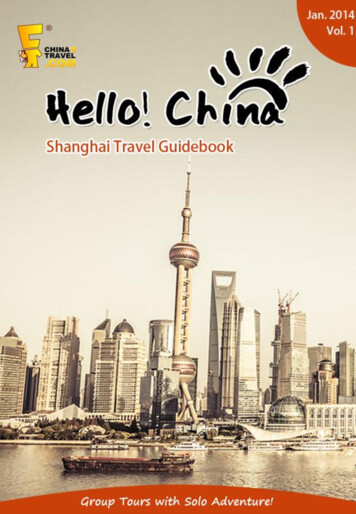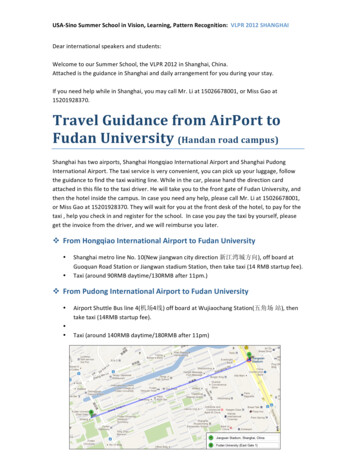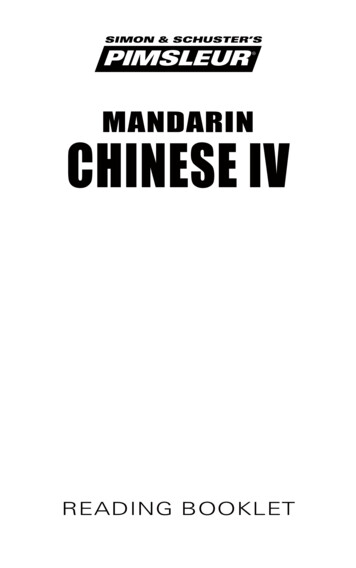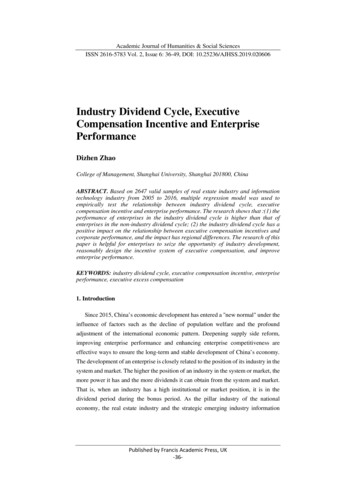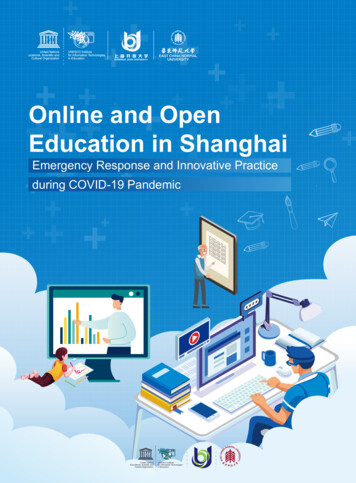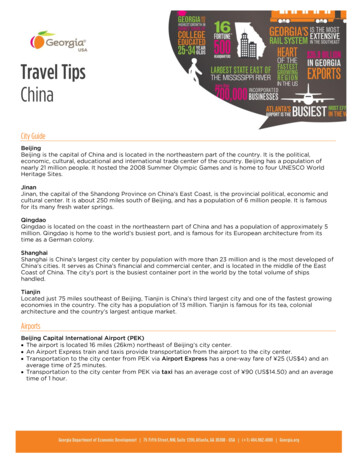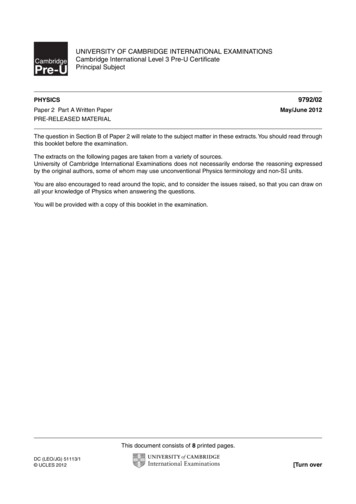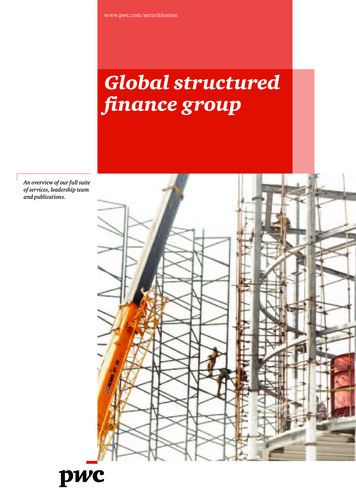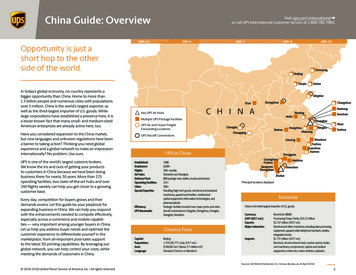
Transcription
25-27 November 2020, NECC, ShanghaiYour Shanghai GuideIn 2020 Hi and Fi Asia-China will once again join together in the NECC, Shanghai with HNC,ProPak China & FoodPack, and Starch Expo, bringing you an extensive offering in healthingredients, food ingredients, nutraceuticals, natural ingredients, starch ingredients, andpackaging and processing solutions – all under one roof.To help you prepare for your trip and make the most of your time in Shanghai, we have put together acity guide which covers everything from visas and currency information to food recommendationsand must-visit tourist attractions.
Things to know before you goCurrency:The official currency in China is the Renminbi (RMB or CNY).The basic unit is the yuan which is sometimes referred to as kuai.General conversion rate:1 EUR 7.78 RMB1 USD 7.12 RMB1 GBP 8.75 RMBCash or Credit CardWe recommend converting some cash to CNY before traveling to Shanghai. You can withdraw cash fromATMs in Shanghai, however, not every machine will accept foreign cards. You will be able to withdrawmoney from international banks such as HSBC and Citi, and the local Chinese bank, China ConstructionBank, accepts VISA and Mastercard. UnionPay credit cards and payment apps Alipay and WeChat Payare how Chinese people pay electronically. A lot of shops and restaurants will only accept these methodsmeaning it can be difficult to use VISA and Mastercard. Establishments geared towards tourists mayaccept international credit cards. Top Tip: Arrive with cash and be willing to take money out of ATMs whilein Shanghai. It can be a bit tricky to connect a foreign account to Alipay and WeChat Pay, so althoughyou can try to use your international credit card, we recommend you always have cash as a back up.VisasWho Needs a Visa?Citizens from Japan, Singapore, Brunei, San Marino, Mauritius, the Seychelles and the Bahamas do notrequire a visa to visit China.Passport ValidityYour passport must be valid for at least six months after the expiry date of your visa (nine months for adouble-entry visa), and you’ll need at least one entire blank page in your passport for the visa.Visa ProcessChina business visa or trade visa, M visa for short, is issued to foreigners coming for commercial and tradeactivities, such as attending trade fairs, visiting clients and factories, negotiating with clients, and signingcontracts. The validity period of China M visa is three months in most cases, while the allowed duration ofstay is usually 30 days and can be longer depending on applicants’ personal casesApplicants are required to provide the following: A copy of flight confirmation showing onward/return travel For double-entry visas, flight confirmation showing all dates of entry andexit If staying at a hotel in China, confirmation from the hotel (this canbe cancelled later if you stay elsewhere and often just showing thefirst night is enough) Application form Invitation letter from the organiser; please contactemma.ruan@imsinoexpo.com for your invitation letterThe cost of a visa really differs depending on your nationality.Below is an indication of some of the costsUK 151 for UK citizensUS 140 for US citizens.US 40 for citizens of other nationsTop tipion onFor full informatsa, visit theapplying for a vition CentreChinaVisa Applica-by-stepwhich provides steptry.guidance by coun
Top tipUsing your PhoneInternational RoamingMost mobile phone providers offer customers international roamingservices when signing up for their phone contract. If you have a verybasic plan, you may not have the option for international roaming.If that is the case, you will not be able to use your mobile phone inShanghai to make calls. If you do have the option for internationalroaming, you usually have to contact your mobile provider to activatethis feature and let them know you will be traveling to China. However,some mobile phone providers may not have roaming services availablein China. If roaming in China is available, keep in mind that roaming canbe very expensive, so make sure to ask your mobile provider about therates for phone calls, text messages, and data usage.in ShanghaiWhen you arrivet, the mostdownload WeChana whichpopular app in Chid video chathas messenger anl as mapcapabilities, as welnctions.and translation futhe app whenIf you downloadna,you haveyou arrive in Chilink yourthe opportunity tohat Pay.credit card to WeCUnlocking your PhoneIf you have an unlocked mobile phone, meaning that your phone is not tied into acertain carrier’s network and will work with more than one service provider, youcan buy a local pre-paid SIM card in China which is often available from shopswithin the airport, at metro stations, hotels, and convenience stores. The costfor a SIM card can be anywhere between RMB 100 to RMB 200 ( 15 to 30)and will have minutes already included. You can top-up your minutes bybuying phone cards from convenience stores and stalls in amounts ofup to RMB 100. Rates are reasonable, and the menu for recharging yourphone is available in English and Mandarin.Using the Internet and AppsMany Western social media apps and some websites are blocked in China underwhat is referred to as The Great Firewall. Blocked social media apps include: Blogspot Pinterest Twitter Facebook Reddit WhatsApp Google Plus Slack YouTube Instagram SnapchatOther notable sites and streaming services banned in China include: ABC Google Reuters BBC Google Docs Wall Street Journal CNN The Guardian Wikipedia (in English) Dropbox Le Monde Yahoo The Economist Netflix Gmail New York TimesTo counter this firewall, you can obtain a Virtual Private Network (VPN)which will allow you to bypass the firewall and access restricted sitesand apps.Top tipPluggenera Sockets: ChllAC. If y uses 220 inaV, 50Hyou areZ,wherethe sta from a countrndvolts at a fre ard of 110- yque120is available, ncy of 60 Hyzto have conv ou will needertdomestic elec ers for yourtrorder to use t ic devices inhem inChina
Local CultureHistorically, Shanghai was a small village which became a hub for foreigners in wartime. As a result, plentyof Western influences are evident in Shanghai, from architecture and lifestyle habits to younger generationsspeaking English. Shanghai is welcoming to foreigners, and although it’s accustomed to internationalinfluences it’s important to acknowledge and be respectful of local culture and etiquette.EtiquetteEveryday Etiquette Shanghai is carrying out the Garbage Classification starting from 1st of July 2019 to protect theenvironment. Four classifications: Organic waste Residual waste Harmful waste Recoverable garbage Personal space is less respected in China. People stand closer to each other in public contexts and whentalking, so do not be offended by somebody standing closer to you than you are used to. It is consideredrude to speak too loudly in public places such as the metro. Pointing is also thought to be rude and shouldbe avoided.Business EtiquetteThe following advice is applicable to business situations. Chinese contacts will not expect you to know andunderstand all customs, but it is a good idea to try and remember the following: Dress neatly in formal conservative attire Avoid staring too directly or pointing at people Light handshakes are favourable over firm Try not to confuse given names and family names. If your Chinese contact has a traditional Chinese namelike Yang Tao, you should address him as Mr. Yang Many Chinese people do not like being on a first-name basis too quickly When receiving a gift or business card, always accept with both hands, study them carefully for a moment,and say thank you Do not interrupt anybody while they are still talking Do not talk over silences, even if they start to feel uncomfortable to you Avoid small talk during the official part of the meeting and politics during small talk.TippingIn general, people do not tip in Shanghai. Tipping in restaurants and bars is uncommon, and taxi drivers arenot tipped. The exception is in Western style hotels and restaurants where 10 -15% is standard for tipping.Getting AroundFrom the Airport:Pudong International Airport is located about 30km from Shanghai city centre. The following are the easiestways to get from the airport to the city or the NECC: Maglev: The Speedy Maglev Train (SMT) is a convenient and fast way to travel towards the downtownarea. Metro line 2 connects with the Maglev Train at Longyang Rd. Station. Alternatively you can takeMetro line 2 directly to the NECC. Taxi: A taxi costs approximately CNY 150 from Pudong Airport toPeople’s Square, the centre of the city, and takes about 50 minutes.Top tiptoThe metro is the fastest wayavoidget around the city as youstraffic jams and busy road
Public TransportAs one of China’s largest and most important cities, Shanghai boastsone of the best city transportation systems in the nation. It may behelpful to purchase a Shanghai Jiaotong Card which can be usedto pay for a majority of trips on the metro, buses, and taxis. Youcan purchase these cards at any metro station as well as in someconvenience stores. Metro: Shanghai is home to the world’s longest metro service,covering 548 km across 337 stations and 14 lines. Single-journey cardscan be purchased at machines inside every metro station. Bus: More than 10 Shanghai bus companies operate 1,400 city buslines in downtown areas and in the suburbs. The city bus fare varies a littleaccording to the vehicle types, but most routes including the downtown,suburban, night and rush-hour lines charge 2 CNY. The downtown shuttle buses onlycost 1 CNY. You can pay in exact change on the bus or use a Shanghai Jiaotong Card. Taxi: Shanghai’s taxis are reasonably cheap, hassle-free, and generally easy to flag down except during rushhour and in summer storms. Taxis fares are metered and tipping is not customary. Uber does not operate inChina, but they do have a local alternative Didi.Things to doIf you have time to spare in Shanghai during your trip, there’s plenty to explore in this vibrant city.Here are some of our top city highlights: The Bund: A mile-long stretch of waterfront promenade along the Huangpu River, The Bund featuresShanghai’s iconic skyline. The promenade is lined with museums, historic buildings, hotels, restaurants,and bars. For the best views, try to visit The Bund at night. Lu Jia Zui: The Oriental Pearl Radio & Television Tower is an iconic Shanghai landmark. Visit the tower forbreathtaking views of the city, or dine in the revolving restaurant inside the sphere. Yu Garden: Believed to have been built during the Ming Dynasty more than 400 years ago, The YuGarden is a Shanghai highlight due to its exquisite layout, beautiful scenery, and the garden’s artisticarchitecture. Nanjing road: If you’re looking for some retail therapy, you’ve come to the right place! This 5.5kmstreet has been a shopping destination for the last 100 years, and you’re guaranteed to find somethingspecial to bring home. Xintiandi: Experience old Shanghai at Xintiandi - now a popular expat hangout with great restaurantsand bars. Zhujiajiao Water Town: Discover the beautiful ancient Zhujiajiao Water Town, regarded as theVenice of Shanghai, located about 50km away from the Bund, Shanghai. Shanghai Disney Resort: Ideal for families and theme park fans, stop bythe magical Shanghai Disney Resort located in Pudong, Shanghai. Massages: After a long day of meetings, a visit to one of Shanghai’smany massage parlours is a must. With so many options available, werecommend you ask for a recommendation at your hotel. Extending your trip? Visit the Dragon Boat Festival, taking place on 25June 2020, the day after the final show day of Hi & Fi Asia-China.The Dragon Boat Festival (端午节) is a traditional Chinese holiday. Duringthis festival, Chinese people traditionally eat zong zi and participate indragon boat racing.In modern China, the festival is known to commemorate the death of thepoet and minister Qu Yuan. It is said that the local people who admiredhim raced in their boats to try to save him. When his body could not befound, the local people dropped balls of sticky rice into the river so that thefish would eat them instead of Qu Yuan’s body. This is said to be the originbehind eating zong zi during the festival.Top tipAlways carry acard with your hoteladdress written inChinese and showthis to taxi driversto avoid potentialcommunicationbarriers.
Eating in ShanghaiDrinking WaterThe tap water in China is not safe to drink. Always buy bottled water whichis easily available in shops and restaurants.What and Where to EatChinese food is one of the most exciting and diverse cuisines in the world. Takeadvantage of your time in Shanghai and try some of the best regional cuisines thatChina has to offer!ShanghaineseShanghainese cuisine, alsoknown as Hu cuisine, can becharacterised by their deep,caramelised savoury flavour thatcomes from the ‘red braising’cooking method in which meatsand vegetables are marinated inwine and herbs and then lightlysimmered. Shanghainese alsoincorporates plenty of fresh ofseafood and vegetables, most ofwhich are accented with a dashof Shaoxing rice wine and Zhejiangvinegar.Top Restaurant Recommendations: Shanghai Tang Cafe (上海滩餐厅) Xin Rong Ji (新荣记) The Hall Off Full Moon (露月喆) Lin Jiang Yan (临江宴)Sichuan and Hunan CuisineSichuan and Hunan cuisineare both known for their spicydishes. Sichuan cuisine includesa distinctive ‘spicy and numbing’seasoning along with othercomplex flavour combinations,often including Sichuan pepperalong with dried chillies andpreserved condiments. Hunancuisine, on the other hand, isknown for being ‘dry and spicy’with a liberal use of chili peppers,shallots, and garlic, and moreoften incorporates smoked andcured goods.Top Restaurant Recommendations: Tian La (天辣) Yu She(余舍酒馆) Ben Lai Boutique SichuanCuisine(本来精品川菜) Ying Shui Fu Rong(映水芙蓉) Xing Xiang Yan (星湘宴) Feng Huang Xiang Yu(凤凰湘语)Cantonese CuisineHot PotHot pot is a Chinesecooking method prepared with asimmering pot of soup stock at thedining table, containing a varietyof East Asian ingredients. Whilethe hot pot is kept simmering, rawingredients such as thinly slicedmeat, vegetables, wontons, eggdumplings, tofu, and seafoodare placed into the pot and arecooked at the table. The cookedfood is usually then eaten with adipping sauce.Top Restaurant Recommendation: Hai Di Lao (海底捞)Cantonese or Yue cuisineoriginates from GuangdongProvince (Southeast China aroundHong Kong), and it is the mostwidely served style of Chinesecuisine in the world. Cantonesefood is known for its lightly cookedfresh vegetables and meat alongwith sweet sauces. Dishes includedifferent kinds of dim sum, roastduck, chicken, pork belly and charsiu pork, sweet and sour dishes,and many more.Top Restaurant Recommendations: Chu Yan (初筵) Dong Fang Si Yan (东方司宴) Jin Ge (锦阁) Chao Jie (潮界) Bi Feng Tang (避风塘) Dian Du De(點都德)OtherIn China’s most cosmopolitan city,you’ll find much more than justtraditional Chinese food. If you’relooking for something a bit differentduring your stay in Shanghai, werecommend you stop by BoxingCat Brewery (拳击猫) located in thefashionable Xintiandi district. Hereyou’ll find a wide variety of popularAmerican and European favouritessuch as burgers, lobster, lasagne,and, of course, a wide variety ofbeers on tap.Top tipchile-long stretmaisdnuThe Bgmenade alonroptnrorfteof wasiver which haRupgnauHthe,f restaurantsoerbmunega hu. Head to thisrsabdna,lshotegfind somethinl’luoydnaareate.for every tas
25-27 November 2020, NECC, Shanghai Your Shanghai Guide In 2020 Hi and Fi Asia-China will once again join together in the NECC, Shanghai with HNC, ProPak China & FoodPack, and Starch Expo, bringing you an extensive offering in health ingredients, food ingredients, nut
